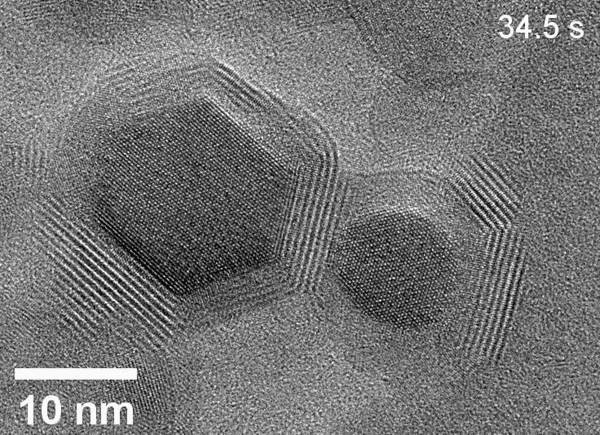A textbook process called “Ostwald ripening,” named after the Nobel Prize-winning chemist Wilhelm Ostwald, has directed the design of new materials such as nanoparticles for decades. These are tiny materials that are so small that they are not visible to the naked eye.
 New video footage captured by Berkeley Lab scientists reveals for the first time that nanoparticle growth is directed not by difference in size, but by defects. Image Credit: Haimei Zheng/Berkeley Lab. Courtesy of Nature Communications.
New video footage captured by Berkeley Lab scientists reveals for the first time that nanoparticle growth is directed not by difference in size, but by defects. Image Credit: Haimei Zheng/Berkeley Lab. Courtesy of Nature Communications.
As per this theory, small particles dissolve and then redeposit onto the surface of huge particles, and the large particles continue to grow until all of the small particles have dissolved.
But at present, new video footage that has been captured by Berkeley Lab researchers discloses that nanoparticle growth has been directed not by differences in size but by flaws.
The scientists recently reported their findings in the Nature Communications journal.
This is a huge milestone. We are rewriting textbook chemistry, and it’s very exciting.
Haimei Zheng, Study Senior Author and Adjunct Professor, Materials Science and Engineering, University of California, Berkeley
Zheng is also a senior scientist in the materials sciences division in Berkeley Lab.
For the study, the scientists suspended a solution of cadmium sulfide (CdS) nanoparticles with hydrogen chloride (HCl) and cadmium chloride (CdCl2) in a custom liquid sample holder.
The scientists uncovered the solution with an electron beam to generate Cd-CdCl2 core-shell nanoparticles (CSNPs) — which appeared to look like a flat, hexagonal disc where cadmium chloride forms the shell and cadmium atoms develop the core.
With the help of a new method known as high-resolution liquid cell transmission electron microscopy (LC-TEM) at the Molecular Foundry, the scientists captured real-time and atomic-scale LC-TEM videos of Cd-CdCl2 CSNPs maturing in solution.
In one of the experiments, an LC-TEM video displays a small Cd-CdCl2 core-shell nanoparticle blending with a huge Cd-CdCl2 CSNP to develop a bigger Cd-CdCl2 CSNP. But the direction of growth was headed not by a variation in size but by a crack defect in the shell of the initially bigger CSNP.
The finding was very unexpected, but we’re very happy with the results.
Qiubo Zhang, Study First Author and Postdoctoral Researcher, Materials Sciences Division, University of California, Berkeley
The scientists state that their work is the highest resolution LC-TEM video that has ever been recorded. The progress — tracking how nanoparticles ripen in solution in real time — was made possible by a custom-made and ultrathin “liquid cell” that holds a small amount of liquid between two carbon-film membranes on a copper grid.
The scientists observed the liquid sample through ThemIS, a specific electron microscope at the Molecular Foundry that has the potential to record atomic-scale variations in liquids at a speed range of 40 to 400 frames per second. The high-vacuum environment of the microscope helps keep the liquid sample intact.
Our study fills in the gap for nanomaterial transformations that can’t be predicted by traditional theory. I hope our work inspires others to think of new rules to design functional nanomaterials for new applications.
Haimei Zheng, Study Senior Author and Adjunct Professor, Materials Science and Engineering, University of California, Berkeley
Zheng pioneered LC-TEM at Berkeley Lab in 2009 and is also a leading expert in the field.
Journal Reference:
Zhang, Q., et al. (2022) Defect-mediated ripening of core-shell nanostructures. Nature Communications. doi.org/10.1038/s41467-022-29847-8.